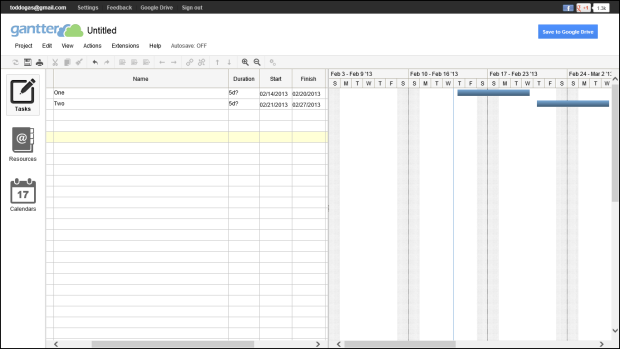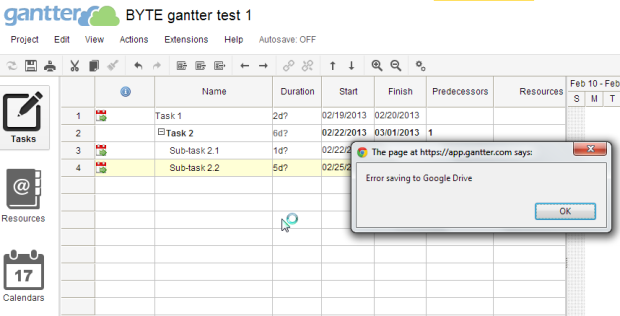Google Drive Third-Party Apps: An Introduction
The ability to install third party Google Drive apps only requires a supported browser and access to the Internet. This has the potential to be a truly disruptive technology for desktop platform ecosystems like Microsoft Windows, Mac OS X, and Linux. However, problems with the basic function of actually saving data to Google Drive by third party apps need to be addressed before widespread adoption is possible.

Google Drive (formerly referred to as Google Docs) provides cloud storage and web-based applications. Up until recently, the handful of applications were all provided by Google and focused on the office functions of word processing (Document), slide deck presentations (Presentation) and spreadsheets (Spreadsheet). On Feb. 8, 2013 Google announced that third-party web applications could be installed and launched from the Google Drive Create button. The ability to access apps from a common Google-provided launch point and work with Google Drive's cloud storage, creates a unified platform that (Google hopes) has the potential to challenge Microsoft's long running dominance of the desktop application space.

Selecting the "Connect more apps" option in the Create button menu lets you browse through these third-party apps for Google Drive.

Currently, there are several dozen Google Drive apps in nine broad app categories: Business Tools, Education, Entertainment, Games, Lifestyle, News & Weather, Productivity, Social & Communication, and Utilities. A 10th category collects the apps developed by Google itself. Some of these apps are the ones that have long been associated with Google Drive. Others (Drawings and Forms) are optional apps. The experimental Fusion Tables data visualization tool is also available.

You can also view Google Drive apps in a collection in Google's Chrome Web Store. Note that while most apps in the Chrome Web Store are intended for use in Google's Chrome web browser, third-party Google Drive apps, like Google's own Drive apps, are browser independent. The screenshot here and a few that follow were taken using Internet Explorer 10 running on a Microsoft Surface with Windows RT tablet.
All of the third-party Google Drive apps are free to install. However, some have fees associated with continued usage or access to additional features. This is not obvious at all if you choose to install an app from the tiled app selection view. It may not be obvious even when reading the product overview page accessed by clicking on a tile. Previously installed apps are identified with a green diagonal band with a white checkmark symbol.

Page 2: Using the apps...
Installing a third-party Google Drive app requires allowing the app to access your account. An "Allow Access" window is presented to you to permit or deny the completion of the app installation process.

Several of the apps I installed and tried have well designed interfaces and are remarkably functional. Gantter, for example, will look and feel comfortable to anyone who has created schedules and Gantt charts using Microsoft Project.

Saving data from a third-party app to Google Drive requires authorization the first time. This is the end of the access-granting process, however.

Like the installation process, permitting initial file saving to Google Drive requires a separate "Allow Access" acknowledgement.

Page 3: Problems with the apps...
Unfortunately, actually saving data to Google Drive from third-party apps proved to be a challenge in some cases. Both Gantter and the otherwise excellent Pixlr Editor (an image editor) both failed to save files to Google Drive. Discussion in Gantter's Get Satisfaction community support page indicates my experience is not an isolated one.


Ironically, both these third-party Google Drive apps were able to save to and load from the local hard drive of my Windows 7 notebook PC.

Name: Google Drive third-party apps
Price: Varies
The ability to install third-party Google Drive apps only requires a supported browser and access to the Internet. This has the potential to be a truly disruptive technology for desktop platform ecosystems like Microsoft Windows, Mac OS X and Linux. However, problems with the basic function of actually saving data to Google Drive by third-party apps need to be addressed before widespread adoption is possible.
Pro:
App installation does not require access to local storage.
Apps available on any browser on any desktop or notebook PC.
Apps appear to be browser independent.
Con:
Problems saving data to Google Drive by some third-party apps.
Fee requirements not clear for some products.
Slow app startup.
Apps not supported in Android or iOS native mobile browsers.
About the Author
You May Also Like




